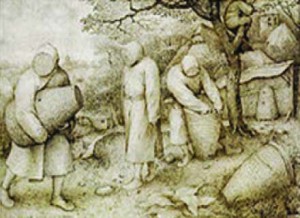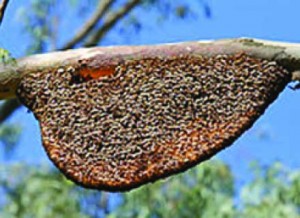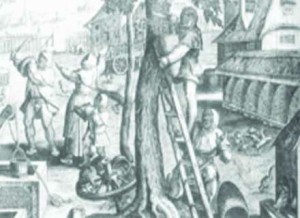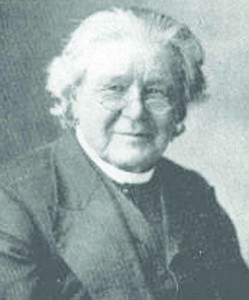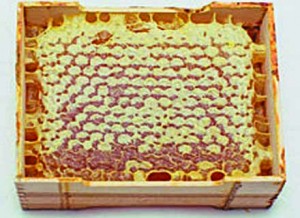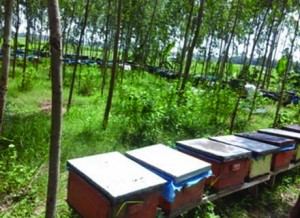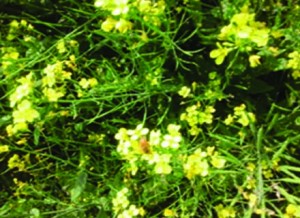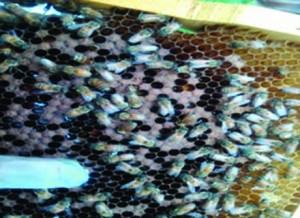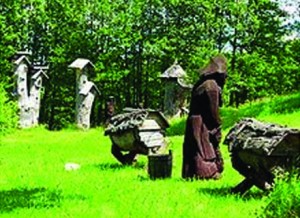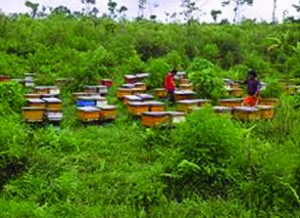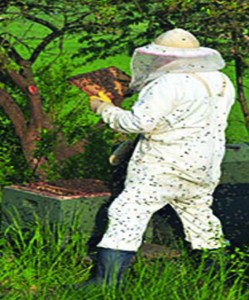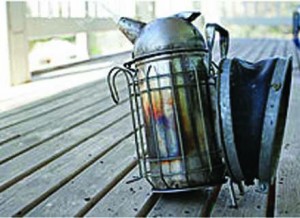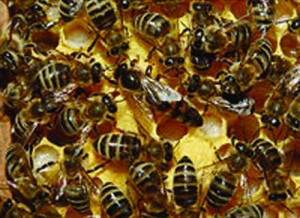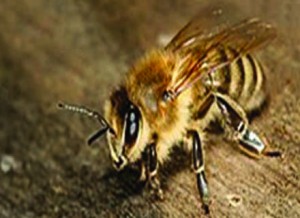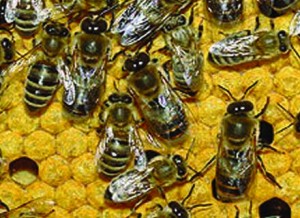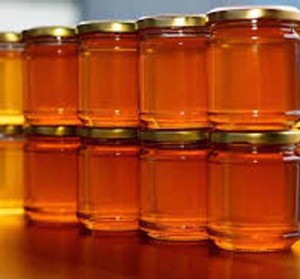Beekeeping or apiculture is the maintenance of honey bee colonies, commonly in man-made hives, by humans. A beekeeper (or apiarist) keeps bees in order to collect their honey and other products that the hive produces (including beeswax, propolis, pollen, and royal jelly), to pollinate crops, or to produce bees for sale to other beekeepers. A location where bees are kept is called an apiary or “bee yard.”
Depictions of humans collecting honey from wild bees date to 10,000 years ago.[2] Beekeeping in pottery vessels began about 9,000 years ago in North Africa.[3] Domestication is shown in Egyptian art from around 4,500 years ago.[4] Simple hives and smoke were used and honey was stored in jars, some of which were found in the tombs of pharaohs such as Tutankhamun. It wasn’t until the 18th century that European understanding of the colonies and biology of bees allowed the construction of the moveable comb hive so that honey could be harvested without destroying the entire colony.
History of beekeeping
At some point humans began to attempt to domesticate wild bees in artificial hives made from hollow logs, wooden boxes, pottery vessels, and woven straw baskets or “skips”. Traces of beeswax are found in pot sherds throughout the Middle East beginning about 7000 BCE.[3]
Honeybees were kept in Egypt from antiquity.[5] On the walls of the sun temple of Nyuserre Ini from the Fifth Dynasty, before 2422 BCE, workers are depicted blowing smoke into hives as they are removing honeycombs.[6] Inscriptions detailing the production of honey are found on the tomb of Pabasa from the Twenty-sixth Dynasty (c. 650 BCE), depicting pouring honey in jars and cylindrical hives.[7] Sealed pots of honey were found in the grave goods of pharaohs such as Tutankhamun.
I am Shamash-resh-u?ur, the governor of Suhu and the land of Mari. Bees that collect honey, which none of my ancestors had ever seen or brought into the land of Suhu, I brought down from the mountain of the men of Habha, and made them settle in the orchards of the town ‘Gabbari-built-it’. They collect honey and wax, and I know how to melt the honey and wax – and the gardeners know too. Whoever comes in the future, may he ask the old men of the town, (who will say) thus: “They are the buildings of Shamash-resh-u?ur, the governor of Suhu, who introduced honey bees into the land of Suhu.”
-translated text from stele, (Dalley, 2002)[8]
In prehistoric Greece (Crete and Mycenae), there existed a system of high-status apiculture, as can be concluded from the finds of hives, smoking pots, honey extractors and other beekeeping paraphernalia in Knossos. Beekeeping was considered a highly valued industry controlled by beekeeping overseers-owners of gold rings depicting apiculture scenes rather than religious ones as they have been reinterpreted recently, contra Sir Arthur Evans.[9]
Archaeological finds relating to beekeeping have been discovered at Rehov, a Bronze and Iron Age archaeological site in the Jordan Valley, Israel.[10] Thirty intact hives, made of straw and unbaked clay, were discovered by archaeologist Amihai Mazar in the ruins of the city, dating from about 900 BCE. The hives were found in orderly rows, three high, in a manner that could have accommodated around 100 hives, held more than 1 million bees and had a potential annual yield of 500 kilograms of honey and 70 kilograms of beeswax, according to Mazar, and are evidence that an advanced honey industry existed in ancient Israel 3,000 years ago.[11][12][13]

Stele showing Shamash-resh-u?ur praying to the gods Adad and Ishtarwith an inscription about beekeeping in Babylonian cuneiform
In ancient Greece, aspects of the lives of bees and beekeeping are discussed at length by Aristotle. Beekeeping was also documented by the Roman writers Virgil, Gaius Julius Hyginus, Varro, and Columella.
Beekeeping has also been practiced in ancient China since antiquity. In the book “Golden Rules of Business Success” written by Fan Li (or Tao Zhu Gong) during the Spring and Autumn period there are sections describing the art of beekeeping, stressing the importance of the quality of the wooden box used and how this can affect the quality of the honey.
The ancient Maya domesticated a separate species of stingless bee. The use of stingless bees is referred to as meliponiculture, named after bees of the tribe Meliponini-such as Melipona quadrifasciata in Brazil. This variation of bee keeping still occurs around the world today.[14]For instance, in Australia, the stingless bee Tetragonula carbonaria is kept for production of their honey.[15]
Origins
There are more than 20,000 species of wild bees.[16] Many species are solitary[17] (e.g., mason bees, leafcutter bees (Megachilidae), carpenter bees and other ground-nesting bees). Many others rear their young in burrows and small colonies (e.g., bumblebees and stingless bees). Some honey bees are wild e.g. the little honeybee (Apis florea), giant honeybee (Apis dorsata) and rock bee (Apis laboriosa). Beekeeping, or apiculture, is concerned with the practical management of the social species of honey bees, which live in large colonies of up to 100,000 individuals. In Europe and America the species universally managed by beekeepers is the Western honey bee (Apis mellifera). This species has several sub-species or regional varieties, such as the Italian bee (Apis mellifera ligustica), European dark bee (Apis mellifera mellifera), and the Carniolan honey bee (Apis mellifera carnica). In the tropics, other species of social bees are managed for honey production, including the Asiatic honey bee (Apis cerana).
All of the Apis mellifera sub-species are capable of inter-breeding and hybridizing. Many bee breeding companies strive to selectively breed and hybridize varieties to produce desirable qualities: disease and parasite resistance, good honey production, swarming behaviour reduction, prolific breeding, and mild disposition. Some of these hybrids are marketed under specific brand names, such as the Buckfast Bee or Midnite Bee. The advantages of the initial F1 hybrids produced by these crosses include: hybrid vigor, increased honey productivity, and greater disease resistance. The disadvantage is that in subsequent generations these advantages may fade away and hybrids tend to be very defensive and aggressive.
Wild honey harvesting
Collecting honey from wild bee colonies is one of the most ancient human activities and is still practiced by aboriginal societies in parts of Africa, Asia, Australia, and South America. In Africa, honeyguide birds have evolved a mutualist relationship with humans, leading them to hives and participating in the feast. This suggests honey harvesting by humans may be of great antiquity. Some of the earliest evidence of gathering honey from wild colonies is from rock paintings, dating to around Upper Paleolithic (13,000 BCE). Gathering honey from wild bee colonies is usually done by subduing the bees with smoke and breaking open the tree or rocks where the colony is located, often resulting in the physical destruction of the nest.
Study of honey bees
It was not until the 18th century that European natural philosophers undertook the scientific study of bee colonies and began to understand the complex and hidden world of bee biology. Preeminent among these scientific pioneers were Swammerdam, René Antoine Ferchault de Réaumur, Charles Bonnet, and François Huber. Swammerdam and Réaumur were among the first to use a microscope and dissection to understand the internal biology of honey bees. Réaumur was among the first to construct a glass walled observation hive to better observe activities within hives. He observed queens laying eggs in open cells, but still had no idea of how a queen was fertilized; nobody had ever witnessed the mating of a queen and drone and many theories held that queens were “self-fertile,” while others believed that a vapor or “miasma” emanating from the drones fertilized queens without direct physical contact. Huber was the first to prove by observation and experiment that queens are physically inseminated by drones outside the confines of hives, usually a great distance away.
Following Réaumur’s design, Huber built improved glass-walled observation hives and sectional hives that could be opened like the leaves of a book. This allowed inspecting individual wax combs and greatly improved direct observation of hive activity. Although he went blind before he was twenty, Huber employed a secretary, François Burnens, to make daily observations, conduct careful experiments, and keep accurate notes over more than twenty years. Huber confirmed that a hive consists of one queen who is the mother of all the female workers and male drones in the colony. He was also the first to confirm that mating with drones takes place outside of hives and that queens are inseminated by a number of successive matings with male drones, high in the air at a great distance from their hive. Together, he and Burnens dissected bees under the microscope and were among the first to describe the ovaries and spermatheca, or sperm store, of queens as well as the penis of male drones. Huber is universally regarded as “the father of modern bee-science” and his “Nouvelles Observations sur Les Abeilles (or “New Observations on Bees”) [18] revealed all the basic scientific truths for the biology and ecology of honeybees.
Invention of the movable comb hive
Early forms of honey collecting entailed the destruction of the entire colony when the honey was harvested. The wild hive was crudely broken into, using smoke to suppress the bees, the honeycombs were torn out and smashed up – along with the eggs, larvae and honey they contained. The liquid honey from the destroyed brood nest was strained through a sieve or basket. This was destructive and unhygienic, but for hunter-gatherer societies this did not matter, since the honey was generally consumed immediately and there were always more wild colonies to exploit. But in settled societies the destruction of the bee colony meant the loss of a valuable resource; this drawback made beekeeping both inefficient and something of a “stop and start” activity. There could be no continuity of production and no possibility of selective breeding, since each bee colony was destroyed at harvest time, along with its precious queen.
During the medieval period abbeys and monasteries were centers of beekeeping, since beeswax was highly prized for candles and fermented honey was used to make alcoholic mead in areas of Europe where vines would not grow. The 18th and 19th centuries saw successive stages of a revolution in beekeeping, which allowed the bees themselves to be preserved when taking the harvest.
Intermediate stages in the transition from the old beekeeping to the new were recorded for example by Thomas Wildman in 1768/1770, who described advances over the destructive old skep-based beekeeping so that the bees no longer had to be killed to harvest the honey.[19] Wildman for example fixed a parallel array of wooden bars across the top of a straw hive or skep (with a separate straw top to be fixed on later) “so that there are in all seven bars of deal” [in a 10-inch-diameter (250 mm) hive] “to which the bees fix their combs.”[20]He also described using such hives in a multi-storey configuration, foreshadowing the modern use of supers: he described adding (at a proper time) successive straw hives below, and eventually removing the ones above when free of brood and filled with honey, so that the bees could be separately preserved at the harvest for a following season. Wildman also described [21] a further development, using hives with “sliding frames” for the bees to build their comb, foreshadowing more modern uses of movable-comb hives.
Wildman’s book acknowledged the advances in knowledge of bees previously made by Swammerdam, Maraldi, and de Réaumur-he included a lengthy translation of Réaumur’s account of the natural history of bees-and he also described the initiatives of others in designing hives for the preservation of bee-life when taking the harvest, citing in particular reports from Brittany dating from the 1750s, due to Comte de la Bourdonnaye. However, the forerunners of the modern hives with movable frames that are mainly used today are considered the traditional basket top bar (movable comb) hives of Greece, known as “Greek beehives”. The oldest testimony on their use dates back to 1669 although it is probable that their use is more than 3000 years old.[22]
The 19th century saw this revolution in beekeeping practice completed through the perfection of the movable comb hive by the American Lorenzo Lorraine Langstroth. Langstroth was the first person to make practical use of Huber’s earlier discovery that there was a specific spatial measurement between the wax combs, later called the bee space, which bees do not block with wax, but keep as a free passage. Having determined this bee space (between 5 and 8 mm, or 1/4 to 3/8″), Langstroth then designed a series of wooden frames within a rectangular hive box, carefully maintaining the correct space between successive frames, and found that the bees would build parallel honeycombs in the box without bonding them to each other or to the hive walls. This enables the beekeeper to slide any frame out of the hive for inspection, without harming the bees or the comb, protecting the eggs, larvae and pupae contained within the cells. It also meant that combs containing honey could be gently removed and the honey extracted without destroying the comb. The emptied honey combs could then be returned to the bees intact for refilling. Langstroth’s book, The Hive and Honey-bee, published in 1853, described his rediscovery of the bee space and the development of his patent movable comb hive.
The invention and development of the movable-comb-hive fostered the growth of commercial honey production on a large scale in both Europe and the US (see also Beekeeping in the United States).
Evolution of hive designs
Langstroth’s design for movable comb hives was seized upon by apiarists and inventors on both sides of the Atlantic and a wide range of moveable comb hives were designed and perfected in England, France, Germany and the United States. Classic designs evolved in each country: Dadant hives and Langstroth hives are still dominant in the US; in France the De-Layens trough-hive became popular and in the UK a British National hive became standard as late as the 1930s although in Scotland the smaller Smith hive is still popular. In some Scandinavian countries and in Russia the traditional trough hive persisted until late in the 20th century and is still kept in some areas. However, the Langstroth and Dadant designs remain ubiquitous in the US and also in many parts of Europe, though Sweden, Denmark, Germany, France and Italy all have their own national hive designs. Regional variations of hive evolved to reflect the climate, floral productivity and the reproductive characteristics of the various subspecies of native honey bee in each bio-region.
The differences in hive dimensions are insignificant in comparison to the common factors in all these hives: they are all square or rectangular; they all use movable wooden frames; they all consist of a floor, brood-box, honey super, crown-board and roof. Hives have traditionally been constructed of cedar, pine, or cypress wood, but in recent years hives made from injection molded dense polystyrene have become increasingly important.
Hives also use queen excluders between the brood-box and honey supers to keep the queen from laying eggs in cells next to those containing honey intended for consumption. Also, with the advent in the 20th century of mite pests, hive floors are often replaced for part of (or the whole) year with a wire mesh and removable tray.
Pioneers of practical and commercial beekeeping
The 19th century produced an explosion of innovators and inventors who perfected the design and production of beehives, systems of management and husbandry, stock improvement by selective breeding, honey extraction and marketing. Preeminent among these innovators were:
Petro Prokopovych, used frames with channels in the side of the woodwork; these were packed side by side in boxes that were stacked one on top of the other. The bees traveled from frame to frame and box to box via the channels. The channels were similar to the cut outs in the sides of modern wooden sections[23] (1814).
Jan Dzier?on, was the father of modern apiology and apiculture. All modern beehives are descendants of his design.
L. L. Langstroth, revered as the “father of American apiculture”; no other individual has influenced modern beekeeping practice more than Lorenzo Lorraine Langstroth. His classic book The Hive and Honey-bee was published in 1853.
Moses Quinby, often termed “the father of commercial beekeeping in the United States”, author of Mysteries of Bee-Keeping Explained.
Amos Root, author of the A B C of Bee Culture, which has been continuously revised and remains in print. Root pioneered the manufacture of hives and the distribution of bee-packages in the United States.
A. J. Cook, author of The Bee-Keepers’ Guide; or Manual of the Apiary, 1876.
Dr. C.C. Miller was one of the first entrepreneurs to actually make a living from apiculture. By 1878 he made beekeeping his sole business activity. His book, Fifty Years Among the Bees, remains a classic and his influence on bee management persists to this day.
Major Francesco De Hruschka was an Italian military officer who made one crucial invention that catalyzed the commercial honey industry. In 1865 he invented a simple machine for extracting honey from the comb by means of centrifugal force. His original idea was simply to support combs in a metal framework and then spin them around within a container to collect honey as it was thrown out by centrifugal force. This meant that honeycombs could be returned to a hive undamaged but empty, saving the bees a vast amount of work, time, and materials. This single invention greatly improved the efficiency of honey harvesting and catalysed the modern honey industry.
Walter T. Kelley was an American pioneer of modern beekeeping in the early and mid-20th century. He greatly improved upon beekeeping equipment and clothing and went on to manufacture these items as well as other equipment. His company sold via catalog worldwide and his book, How to Keep Bees & Sell Honey, an introductory book of apiculture and marketing, allowed for a boom in beekeeping following World War II.
In the U.K. practical beekeeping was led in the early 20th century by a few men, pre-eminently Brother Adam and his Buckfast bee and R.O.B. Manley, author of many titles, including Honey Production in the British Isles and inventor of the Manley frame, still universally popular in the U.K. Other notable British pioneers include William Herrod-Hempsall and Gale.
Dr. Ahmed Zaky Abushady (1892-1955), was an Egyptian poet, medical doctor, bacteriologist and bee scientist who was active in England and in Egypt in the early part of the twentieth century. In 1919, Abushady patented a removable, standardized aluminum honeycomb. In 1919 he also founded The Apis Club in Benson, Oxfordshire, and its periodical Bee World, which was to be edited by Annie D. Betts and later by Dr. Eva Crane. The Apis Club was transitioned to the International Bee Research Association (IBRA). Its archives are held in the National Library of Wales. In Egypt in the 1930s, Abushady established The Bee Kingdom League and its organ, The Bee Kingdom.
In India, R. N. Mattoo was the pioneer worker in starting beekeeping with Indian honeybee, (Apis cerana indica) in early 1930s. Beekeeping with European honeybee, (Apis mellifera) was started by Dr. A. S. Atwal and his team members, O. P. Sharma and N. P. Goyal in Punjab in early 1960s.It remained confined to Punjab and Himachal Pradesh up to late 1970s. Later on in 1982, Dr. R. C. Sihag, working at Haryana Agricultural University, Hisar (Haryana), introduced and established this honeybee in Haryana and standardized its management practices for semi-arid-subtropical climates.On the basis of these practices, beekeeping with this honeybee could be extended to the rest of the country. Now beekeeping with Apis mellifera predominates in India.
History of Apiculture in Bangladesh
In the 1960’s Bangladesh Small & Cottage Industries Corporation (BSCIC) started beekeeping in wooden hives at Jatrapur under Khulna. The result at that time was not also satisfactory due to inappropriate technology and ultimately the activities were stopped in the same decade. In 1977 BSCIC again started beekeeping in modern and scientific way. Having successful efforts promotion and extension of beekeeping activities is being launched by BSCIC throughout the country since 1977. Now on realizing the importance and utility of honey, other bee products and beekeeping, many other organizations started and assisted modern beekeeping in the country. However, no attempt was made prior to BSCIC in the past to introduce modern, scientific and systematic beekeeping in Bangladesh. Now BSCIC is implementing the beekeeping Project for the period of 1990-2005.
(Reference: Beekeeping for Rural Development, Its Potentiality and Beekeeping against Poverty-Bangladesh Perspective -J. Ch. Sah)
Objectives of the project are:
1. Identification and utilization of the honey resource areas in the country;
2. Propagation and familiarization of the scientific methods of beekeeping through training and demonstration;
3. Increasing of the production of quality crops, fruits, vegetables and seeds through cross-pollination;
4. Plantation in the view point of bee-plants and environment as well;
5. Poverty alleviation, employment and income generation, production of pure honey in the form of rural development in the country.
Current Situation
It may be mentioned here that in most of the 86 thousand villages in Bangladesh beekeeping is more or less feasible on the basis of existing natural bee plants. So it is to be expected that if there would be at least 5 beekeeping in each village in average then there would be more than 0.4 million people to be engaged in bee-keeping activities.
By way of this 0.4 million people to be engaged in keeping bees and when each bee-keeper on average will produce 10 kg of honey then there would be a total honey production of about 4,000 metric tons which is worth TK. 800 (US$ 14 millions) millions per year. On the other hand additional crop, vegetable and fruit production as per scientific record is to be worth Tk. 8000 (US$140 millions) millions by way of pollination through bee-keeping activities in the country. So it is to be appreciable that through the scientific and proper implementation and expansion of beekeeping through research and demonstration in the country there will be a good amount of honey production with enhanced crop, vegetable and fruit production. Subsequently a large number of employment generation is also to be happened as well.
(Reference: Beekeeping for Rural Development, Its Potentiality and Beekeeping against Poverty- Bangladesh Perspective -J. Ch. Saha)
Nevertheless, in the context of large unrealized potentiality of rural beekeeping in Bangladesh the following socio-economic benefits can be achieved:
- Promotion and enhancement of agricultural production;
- Enhancement of the quality and production of fruits;
- Promotion and expansion of forest wealth;
- Increasing plant community in the environment.
- Saving and/or earning foreign currency by producing and/or exporting honey and other bee products;
- Prevention of diseases by taking pure honey regularly;
- Curing of some particular diseases;
- Promotion and increasing the nutrition value of food;
- Use of wax and other bee products in various industrial products;
- Promotion of medicine quality;
- Upgrading the quality and standard of food in the view point of taste and nutrition;
- Increasing the rural based cottage industry in the country;
- Family solvency through additional income broadly in the rural areas;
- New employment generation by way of rural beekeeping extension;
- Accelerating the development of national economy.
Albert Einstein Says “If the bee disappears from the surface of the Earth, man would have no more than four years left to live.” So can you imagine the importance of honeybee for our existence!!
The subject that deals with the management technique of honeybee rearing, collection of honey , making honey products is generally called Apiculture . Apiculture is a vast scientific subject, related to agriculture, food, nutrition, medicine, industrial products and environment.
Fixed comb hives
A fixed comb hive is a hive in which the combs cannot be removed or manipulated for management or harvesting without permanently damaging the comb. Almost any hollow structure can be used for this purpose, such as a log gum, skep, wooden box, or a clay pot or tube. Fixed comb hives are no longer in common use in industrialized countries, and are illegal in places that require movable combs to inspect for problems such as varroa and American foulbrood. In many developing countries fixed comb hives are widely used and, because they can be made from any locally available material, are very inexpensive.
Beekeeping using fixed comb hives is an essential part of the livelihoods of many communities in poor countries. The charity Bees for Development recognizes that local skills to manage bees in fixed comb hives[24] are widespread in Africa, Asia, and South America. Internal size of fixed comb hives range from 32.7 liters (2000 cubic inches) typical of the clay tube hives used in Egypt to 282 liters (17209 cubic inches) for the Perone hive. Straw skeps, bee gums, and unframed box hives are unlawful in most US states, as the comb and brood cannot be inspected for diseases. However, skeps are still used for collecting swarms by hobbyists in the UK, before moving them into standard hives. Quinby used box hives to produce so much honey that he saturated the New York market in the 1860s. His writings contain excellent advice for management of bees in fixed comb hives.
Modern beekeeping
Top-bar hives
Top bar hives have been widely adopted in Africa where they are used to keep tropical honeybee ecotypes. Their advantages include being light weight, adaptable, easy to harvest honey, and less stressful for the bees. Disadvantages include combs that are fragile and cannot usually be extracted and returned to the bees to be refilled and that they cannot easily be expanded for additional honey storage.
A growing number of amateur beekeepers are adopting various top-bar hives similar to the type commonly found in Africa. Top bar hives were originally used as a traditional beekeeping method in Greece and Vietnam with a history dating back over 2000 years.[13] These hives have no frames and the honey-filled comb is not returned after extraction. Because of this, the production of honey is likely to be somewhat less than that of a frame and super based hive such as Langstroth or Dadant. Top bar hives are mostly kept by people who are more interested in having bees in their garden than in honey production per se. Some of the most well known top-bar hive designs are the Kenyan Top Bar Hive with sloping sides, the Tanzanian Top Bar Hive with straight sides, and Vertical Top Bar Hives, such as the Warre or “People’s Hive” designed by Abbe Warre in the mid-1900s.
The initial costs and equipment requirements are typically much less than other hive designs. Scrap wood or #2 or #3 pine can often be used to build a nice hive. Top-bar hives also offer some advantages to interacting with the bees and the amount of weight that must be lifted is greatly reduced. Top-bar hives are being widely used in developing countries in Africa and Asia as a result of the Bees for Development program. Since 2011, a growing number of beekeepers in the U.S. are using various top-bar hives.
Horizontal frame hives
The De-Layens hive, Jackson Horizontal Hive, and various chest type hives are widely used in Spain, France, Ukraine, Belarus, Africa, and parts of Russia. They are a step up from fixed comb and top bar hives because they have movable frames that can be extracted. Their limitation is primarily that volume is fixed and not easily expanded. Honey has to be removed one frame at a time, extracted or crushed, and the empty frames returned to be refilled. Various horizontal hives have been adapted and widely used for commercial migratory beekeeping. The Jackson Horizontal Hive is particularly well adapted for tropical agriculture. The De-Layens hive is popular in parts of Spain.
Vertical stackable frame hives
In the United States, the Langstroth hive is commonly used. The Langstroth was the first successful top-opened hive with movable frames. Many other hive designs are based on the principle of bee space first described by Langstroth. The Langstroth hive is a descendant of Jan Dzierzon’s Polish hive designs. In the United Kingdom, the most common type of hive is the British National, which can hold Hoffman, British Standard or Manley frames. It is not unusual to see some other sorts of hive (Smith, Commercial, WBC, Langstroth, and Rose). Dadant and Modified Dadant hives are widely used in France and Italy where their large size is an advantage. Square Dadant hives – often called 12 frame Dadant or Brother Adam hives – are used in large parts of Germany and other parts of Europe by commercial beekeepers. The Rose hive is a modern design that attempts to address many of the flaws and limitations of other movable frame hives. The only significant weakness of the Rose design is that it requires 2 or 3 boxes as a brood nest which infers a large number of frames to be worked when managing the bees. The major advantage shared by these designs is that additional brood and honey storage space can be added via boxes of frames added to the hive. This also simplifies honey collection since an entire box of honey can be removed instead of removing one frame at a time.
Protective clothing
Most beekeepers also wear some protective clothing. Novice beekeepers usually wear gloves and a hooded suit or hat and veil. Experienced beekeepers sometimes elect not to use gloves because they inhibit delicate manipulations. The face and neck are the most important areas to protect, so most beekeepers wear at least a veil. Defensive bees are attracted to the breath, and a sting on the face can lead to much more pain and swelling than a sting elsewhere, while a sting on a bare hand can usually be quickly removed by fingernail scrape to reduce the amount of venom injected.
The protective clothing is generally light colored (but not colorful) and of a smooth material. This provides the maximum differentiation from the colony’s natural predators (such as bears and skunks) which tend to be dark-colored and furry.
‘Stings’ retained in clothing fabric continue to pump out an alarm pheromone that attracts aggressive action and further stinging attacks. Washing suits regularly and rinsing gloved hands in vinegar minimizes attraction.
Smoker
Smoke is the beekeeper’s third line of defense. Most beekeepers use a “smoker”-a device designed to generate smoke from the incomplete combustion of various fuels. Smoke calms bees; it initiates a feeding response in anticipation of possible hive abandonment due to fire.[26] Smoke also masks alarm pheromones released by guard bees or when bees are squashed in an inspection. The ensuing confusion creates an opportunity for the beekeeper to open the hive and work without triggering a defensive reaction. In addition, when a bee consumes honey the bee’s abdomen distends, supposedly making it difficult to make the necessary flexes to sting, though this has not been tested scientifically.
Smoke is of questionable use with a swarm, because swarms do not have honey stores to feed on in response. Usually smoke is not needed, since swarms tend to be less defensive, as they have no stores or brood to defend, and a fresh swarm has fed well from the hive.
Many types of fuel can be used in a smoker as long as it is natural and not contaminated with harmful substances. These fuels include hessian, twine, burlap, pine needles, corrugated cardboard, and mostly rotten or punky wood. Indian beekeepers, especially in Kerala, often use coconut fibers as they are readily available, safe, and of negligible expense. Some beekeeping supply sources also sell commercial fuels like pulped paper and compressed cotton, or even aerosol cans of smoke. Other beekeepers use sumac as fuel because it ejects lots of smoke and doesn’t have an odor.
Some beekeepers are using “liquid smoke” as a safer, more convenient alternative. It is a water-based solution that is sprayed onto the bees from a plastic spray bottle.
Torpor may also be induced by the introduction of chilled air into the hive – while chilled carbon dioxide may have harmful long-term effects.
Urban or backyard beekeeping
Related to natural beekeeping, urban beekeeping is an attempt to revert to a less industrialized way of obtaining honey by utilizing small-scale colonies that pollinate urban gardens. Urban apiculture has undergone a renaissance in the first decade of the 21st century, and urban beekeeping is seen by many as a growing trend.
Some have found that “city bees” are actually healthier than “rural bees” because there are fewer pesticides and greater biodiversity. Urban bees may fail to find forage, however, and homeowners can use their landscapes to help feed local bee populations by planting flowers that provide nectar and pollen. An environment of year-round, uninterrupted bloom creates an ideal environment for colony reproduction.
Bee colonies
A colony of bees consists of three castes of bee:
1. a queen bee, which is normally the only breeding female in the colony;
2. a large number of female worker bees, typically 30,000-50,000 in number;
3. a number of male drones, ranging from thousands in a strong hive in spring to very few during dearth or cold season.
The queen is the only sexually mature female in the hive and all of the female worker bees and male drones are her offspring. The queen may live for up to three years or more and may be capable of laying half a million eggs or more in her lifetime. At the peak of the breeding season, late spring to summer, a good queen may be capable of laying 3,000 eggs in one day, more than her own body weight. This would be exceptional however; a prolific queen might peak at 2,000 eggs a day, but a more average queen might lay just 1,500 eggs per day. The queen is raised from a normal worker egg, but is fed a larger amount of royal jelly than a normal worker bee, resulting in a radically different growth and metamorphosis. The queen influences the colony by the production and dissemination of a variety of pheromones or “queen substances”. One of these chemicals suppresses the development of ovaries in all the female worker bees in the hive and prevents them from laying eggs.
Mating of queens
The queen emerges from her cell after 15 days of development and she remains in the hive for 3-7 days before venturing out on a mating flight. Mating flight is otherwise known as “nuptial flight”. Her first orientation flight may only last a few seconds, just enough to mark the position of the hive. Subsequent mating flights may last from 5 minutes to 30 minutes, and she may mate with a number of male drones on each flight. Over several matings, possibly a dozen or more, the queen receives and stores enough sperm from a succession of drones to fertilize hundreds of thousands of eggs. If she does not manage to leave the hive to mate-possibly due to bad weather or being trapped in part of the hive-she remains infertile and becomes a drone layer, incapable of producing female worker bees. Worker bees sometimes kill a non-performing queen and produce another. Without a properly performing queen, the hive is doomed.
Mating takes place at some distance from the hive and often several hundred feet in the air; it is thought that this separates the strongest drones from the weaker ones, ensuring that only the fastest and strongest drones get to pass on their genes.
Worker bees
Most of the bees in a hive are female worker bees. At the height of summer when activity in the hive is frantic and work goes on non-stop, the life of a worker bee may be as short as 6 weeks; in late autumn, when no brood is being raised and no nectar is being harvested, a young bee may live for 16 weeks, right through the winter.
Over the course of their lives, worker bees’ duties are dictated by age. For the first few weeks of their lifespan, they perform basic chores within the hive: cleaning empty brood cells, removing debris and other housekeeping tasks, making wax for building or repairing comb, and feeding larvae. Later, they may ventilate the hive or guard the entrance. Older workers leave the hive daily, weather permitting, to forage for nectar, pollen, water, and propolis.
Drones
Drones are the largest bees in the hive (except for the queen), at almost twice the size of a worker bee. Note in the picture that they have much larger eyes than the workers have, presumably to better locate the queen during the mating flight. They do not work, do not forage for pollen or nectar, are unable to sting, and have no other known function than to mate with new queens and fertilize them on their mating flights. A bee colony generally starts to raise drones a few weeks before building queen cells so they can supersede a failing queen or prepare for swarming. When queen-raising for the season is over, bees in colder climates drive drones out of the hive to die, biting and tearing their legs and wings.
Differing stages of development
Diseases
The common agents of disease that affect adult honey bees include fungi, bacteria, protozoa, viruses, parasites, and poisons. The gross symptoms displayed by affected adult bees are very similar, whatever the cause, making it difficult for the apiarist to ascertain the causes of problems without microscopic identification of microorganisms or chemical analysis of poisons.[37] Since 2006 colony losses from Colony Collapse Disorder have been increasing across the world although the causes of the syndrome are, as yet, unknown. In the US, commercial beekeepers have been increasing the number of hives to deal with higher rates of attrition.
Parasites
Galleria mellonella “wax moth” larvae that hatch, tunnel through, and destroy comb that contains bee larvae and their honey stores. The tunnels they create are lined with silk, which entangles and starves emerging bees. Destruction of honeycombs also results in honey leaking and being wasted.[41]


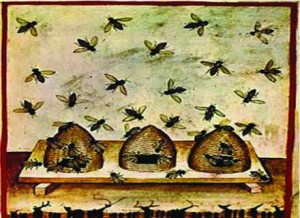
![Honey seeker depicted on 8000-year-old cave painting near Valencia, Spain[1]](https://theguardianbd.net/wp-content/uploads/2018/06/2-300x218.jpg)
